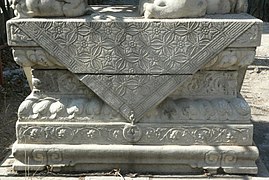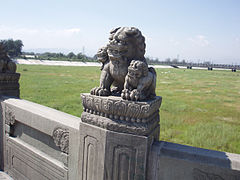Guardian lion
| Guardian lion - 石獅 | |
|---|---|
| Stone Lion - Summer Palace , Beijing 2005 | |
| Chinese name | |
| Long characters | 石獅 |
| Abbreviation | 石狮 |
| Pinyin | Shíshī |
| Jyutping | Sec 6 si 1 |
| Alternative name | |
| Long characters | 石 獅子 |
| Abbreviation | 石 狮子 |
| Pinyin | Shíshīzi |
| Jyutping | Sec 6 si 1 zi 2 |
| Japanese name | |
| Kanji | 獅子 |
| Hiragana | し し |
| Hepburn | Shishi |
| Ryūkyū name | |
| Katakana | シ ー サ ー |
| Hepburn | Shīsā |
| Okinawa | Shiisaa |
| Guardian Lions, Forbidden City 2005 | |
The guardian lion ( Chinese 石獅 / 石狮 , pinyin shíshī , also 石 獅子 / 石 狮子 , shíshīzi - "stone lion") is a popular representation of animals in Chinese art . A pair of guardian lions can often be seen in front of many house entrances, especially in front of the entrances to traditional buildings. These guardian figures are mostly made of stone , but also iron or bronze . Therefore, the Chinese word guardian lion literally means stone lion . They often stand in front of the entrance to public buildings and flank the entrance doors of important secular or religious buildings, such as palaces , government buildings or the residences of high officials. They guard the entrance to Buddhist temples and pagodas . They stand as protective figures in front of bridges and banks and act as grave guards at grave sites or mausoleums . A well-known example is the Lugouqiao , also known as the “ Marco Polo Bridge ”, near Beijing. On it stand 501 lions in different sizes and positions. There is a pair of guardian lions in front of the Forbidden City in Beijing . Stone lions are also set up inside buildings, for example on desks, sideboards and in front of rooms that require protection. The tradition of the guardian lion has its origins in Buddhism and, through its dissemination, found its way into neighboring countries of China and influenced similar figures in neighboring regions, e.g. B. the Komainu ( Japanese 狛 犬 ) or Shishi ( Japanese 獅子 ) in Japan . Local in Okinawa on the Ryūkyū Islands known as Shīsā ( Japanese シ ー サ ー , okinawa shiisaa).
history
At the beginning of Chinese history, stone lions did not exist, as lions did not occur in China and were therefore unknown. With the spread of Buddhism from India to China in the 3rd century , Chinese sculptors lacked real models for lions. Since they felt a certain resemblance between the lion's head and that of the Chinese Pekingese dog, they adopted elements of this dog in their sculptures and mixed them with those of the lion. The Chinese term for lion shi ( 獅 / 狮 , shí ) was probably borrowed from the Persian šer , which in turn indicates that the lion itself was not directly adopted from India.
There were stone lions in front of the entrances not only in the imperial palace, but also in front of the houses of high-ranking personalities. In doing so, the number of curls that make up the lion's mane indicates their rank. The lions of the officials of the highest rank had thirteen locks, and with each degree that the rank of officer decreased, so did the number of locks. However, officials below the seventh grade were not allowed to put lions in front of their homes.
symbolism
Lions act in pairs as a guard, the right lion is male and holding under his right paw ball ( 繡球 / 绣球 , Xiuqiu - "literally" embroidered ball, "mutatis mutandis" embroidered ball with happiness symbols versed "") A . The lion on the left is female and holds a lion cub under his left paw. The lion stands for strength and power. The ball ( Xiuqiu ), originally a pearl, of the male lion symbolizes the unity and power of the empire. The lioness with the cub stands for the prosperity of the offspring, growth and well-being. Lions are said to have the power and strength to keep bad influences of all kinds away.
- Stone lion - details
Guardian lion on the Marco Polo Bridge , 2005
- annotation
literature
- Wolfram Eberhard: Lexicon of Chinese symbols. The imagery of the Chinese. Heinrich Hugendubel, Munich 2004, ISBN 3-89631-428-9 , pp. 181-182
- Jeremy Roberts: Chinese Mythology AZ. 2nd Edition, Chelsea House Publications 2009, ISBN 978-1-60413-436-0 , pp. 73-74.
Trivia
In the Chinese province of Fujian there is the independent city of Shishi , which literally means "stone lion city".
See also
- Komainu
- Lion dance
- Siling (mythology) - "Four wonder animals"
Web links
-
The Met: Digital Collection - Netsuke: Masterpieces from the Metropolitan Museum of Art - Barbra Teri Okada
Exhibition catalog with many exhibits on Chinese guardian lions
Individual evidence
- ↑ LER Picken: Music for a Lion-Dance of the Song Dynasty . In: Laurence Picken (Ed.): Musica Asiatica . tape 4 . Cambridge University Press, 1984, ISBN 0-521-27837-6 , pp. 201 ( limited preview in Google Book Search [accessed September 20, 2017]).





